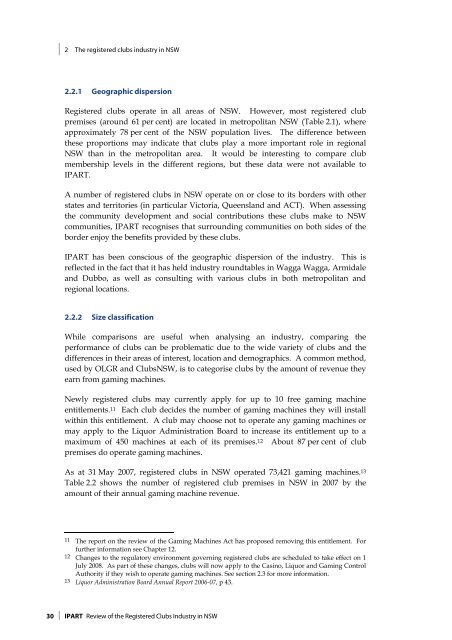Review of the Registered Clubs Industry in NSW - Clubs NSW
Review of the Registered Clubs Industry in NSW - Clubs NSW
Review of the Registered Clubs Industry in NSW - Clubs NSW
You also want an ePaper? Increase the reach of your titles
YUMPU automatically turns print PDFs into web optimized ePapers that Google loves.
2 The registered clubs <strong>in</strong>dustry <strong>in</strong> <strong>NSW</strong><br />
2.2.1 Geographic dispersion<br />
<strong>Registered</strong> clubs operate <strong>in</strong> all areas <strong>of</strong> <strong>NSW</strong>. However, most registered club<br />
premises (around 61 per cent) are located <strong>in</strong> metropolitan <strong>NSW</strong> (Table 2.1), where<br />
approximately 78 per cent <strong>of</strong> <strong>the</strong> <strong>NSW</strong> population lives. The difference between<br />
<strong>the</strong>se proportions may <strong>in</strong>dicate that clubs play a more important role <strong>in</strong> regional<br />
<strong>NSW</strong> than <strong>in</strong> <strong>the</strong> metropolitan area. It would be <strong>in</strong>terest<strong>in</strong>g to compare club<br />
membership levels <strong>in</strong> <strong>the</strong> different regions, but <strong>the</strong>se data were not available to<br />
IPART.<br />
A number <strong>of</strong> registered clubs <strong>in</strong> <strong>NSW</strong> operate on or close to its borders with o<strong>the</strong>r<br />
states and territories (<strong>in</strong> particular Victoria, Queensland and ACT). When assess<strong>in</strong>g<br />
<strong>the</strong> community development and social contributions <strong>the</strong>se clubs make to <strong>NSW</strong><br />
communities, IPART recognises that surround<strong>in</strong>g communities on both sides <strong>of</strong> <strong>the</strong><br />
border enjoy <strong>the</strong> benefits provided by <strong>the</strong>se clubs.<br />
IPART has been conscious <strong>of</strong> <strong>the</strong> geographic dispersion <strong>of</strong> <strong>the</strong> <strong>in</strong>dustry. This is<br />
reflected <strong>in</strong> <strong>the</strong> fact that it has held <strong>in</strong>dustry roundtables <strong>in</strong> Wagga Wagga, Armidale<br />
and Dubbo, as well as consult<strong>in</strong>g with various clubs <strong>in</strong> both metropolitan and<br />
regional locations.<br />
2.2.2 Size classification<br />
While comparisons are useful when analys<strong>in</strong>g an <strong>in</strong>dustry, compar<strong>in</strong>g <strong>the</strong><br />
performance <strong>of</strong> clubs can be problematic due to <strong>the</strong> wide variety <strong>of</strong> clubs and <strong>the</strong><br />
differences <strong>in</strong> <strong>the</strong>ir areas <strong>of</strong> <strong>in</strong>terest, location and demographics. A common method,<br />
used by OLGR and <strong>Clubs</strong><strong>NSW</strong>, is to categorise clubs by <strong>the</strong> amount <strong>of</strong> revenue <strong>the</strong>y<br />
earn from gam<strong>in</strong>g mach<strong>in</strong>es.<br />
Newly registered clubs may currently apply for up to 10 free gam<strong>in</strong>g mach<strong>in</strong>e<br />
entitlements. 11 Each club decides <strong>the</strong> number <strong>of</strong> gam<strong>in</strong>g mach<strong>in</strong>es <strong>the</strong>y will <strong>in</strong>stall<br />
with<strong>in</strong> this entitlement. A club may choose not to operate any gam<strong>in</strong>g mach<strong>in</strong>es or<br />
may apply to <strong>the</strong> Liquor Adm<strong>in</strong>istration Board to <strong>in</strong>crease its entitlement up to a<br />
maximum <strong>of</strong> 450 mach<strong>in</strong>es at each <strong>of</strong> its premises. 12 About 87 per cent <strong>of</strong> club<br />
premises do operate gam<strong>in</strong>g mach<strong>in</strong>es.<br />
As at 31 May 2007, registered clubs <strong>in</strong> <strong>NSW</strong> operated 73,421 gam<strong>in</strong>g mach<strong>in</strong>es. 13<br />
Table 2.2 shows <strong>the</strong> number <strong>of</strong> registered club premises <strong>in</strong> <strong>NSW</strong> <strong>in</strong> 2007 by <strong>the</strong><br />
amount <strong>of</strong> <strong>the</strong>ir annual gam<strong>in</strong>g mach<strong>in</strong>e revenue.<br />
11 The report on <strong>the</strong> review <strong>of</strong> <strong>the</strong> Gam<strong>in</strong>g Mach<strong>in</strong>es Act has proposed remov<strong>in</strong>g this entitlement. For<br />
fur<strong>the</strong>r <strong>in</strong>formation see Chapter 12.<br />
12 Changes to <strong>the</strong> regulatory environment govern<strong>in</strong>g registered clubs are scheduled to take effect on 1<br />
July 2008. As part <strong>of</strong> <strong>the</strong>se changes, clubs will now apply to <strong>the</strong> Cas<strong>in</strong>o, Liquor and Gam<strong>in</strong>g Control<br />
Authority if <strong>the</strong>y wish to operate gam<strong>in</strong>g mach<strong>in</strong>es. See section 2.3 for more <strong>in</strong>formation.<br />
13 Liquor Adm<strong>in</strong>istration Board Annual Report 2006-07, p 43.<br />
30 IPART <strong>Review</strong> <strong>of</strong> <strong>the</strong> <strong>Registered</strong> <strong>Clubs</strong> <strong>Industry</strong> <strong>in</strong> <strong>NSW</strong>
















